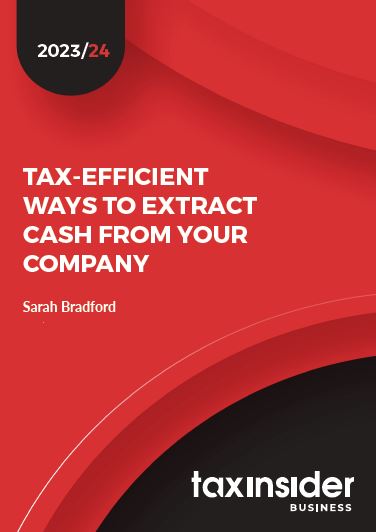
For more in depth discussion on this important area of business taxation, please see our newly updated report ‘Tax Efficient Ways To Extract Cash From Your Company’.
-----------------------------------
Family and owner-managed companies can freely decide how much of their profits should be returned to the shareholders or retained within the business.
Most discussions about profit extraction usually start by focusing on the amount available to be paid out to the owner-managers. This is generally influenced by one or more of the following factors:
- the amount required for future retention in the business (to satisfy future working capital or capital investment purposes);
- the level of the company’s distributable reserves and ‘free’ cash flow;
- any provisions or restrictions laid down in Shareholder Agreements or a company’s Articles, particularly where venture capital finance has been used; and
- the shareholders’ personal ‘income’ requirements and tax position (and the impact of the 45% (salaries and bonuses) and/or 39.35% (dividend) income tax rates!)
With the increased levels of effective tax rates, many owner-managers are likely to retain more profits within their companies, particularly after 6 April 2023. Within these constraints, some owner-managers may still wish to regularly remove ‘surplus’ cash from the business so as to remove it from any further business risk (subject to the requirements of the Insolvency Act 1986).
Extracting funds from the company
Owner-managers can extract funds from the company in various ways. Typically, the working shareholders may well, in addition to drawing a normal salary, decide whether to extract surplus profits by means of a bonus or dividend.
Hitherto, the high levels of National Insurance contributions (NICs) have meant that more owner-managers have tended to draw all or a substantial part of their profits in the form of dividends. It is often sensible to extract a reasonable level of salary, even if it is at least sufficient salary to maintain NICs records such that each year is a qualifying year for state pension ‘accrual’ purposes.
For 2023/24, directors and employees suffer 12% NICs on their earnings between £242 and £967 per week (or if earnings are calculated on an annual basis, £12,570 and £50,270). An additional employee NICs charge of 2% is levied on ALL earnings exceeding the upper earnings limit of £50,270.
For those owner-managers with the ‘work till you drop’ ethos, employees’ NICs cease to be payable on their earnings after they have reached ‘pensionable age’. Special exemptions apply for certain apprentices and ‘young’ employees.
In 2023/24, businesses continue to pay 13.8% employer’s NICs on all director and employee earnings above £175 per week (£9,100 on an annual basis fixed until April 2028). Employer NICs still remain payable for employees that have reached state pension age.
Certain smaller businesses may be able to benefit from the annual employer allowance that exempts them from paying the first £5,000 of NICs.
Dividends
If the company extracts surplus funds by means of a dividend, the relatively high cost of NICs is avoided. The National Insurance Contributions Office (NICO) may seek to challenge dividends which have not been declared in accordance with the relevant Companies Act formalities.
In 2023/24, the recently increased dividend rates remain subject to a change in the top tax rate threshold (reduced to £125,140 from £150,000).
Dividends are always taxed as the highest slice of taxable income. Ignoring the personal allowance and the dividend allowance (reduced to £1,000), the relevant rates are currently as follows:
|
Dividend tax rates – 2022/23 |
||
|
Taxable dividend income received
|
Tax rate |
|
|
Up to £37,700 |
8.75% |
|
|
Between £37,700 and £125,140 |
33.75% |
|
|
Above £125,140 |
39.35% |
|
Scottish taxpayers are subject to different tax rates or bands on their earned income (but not dividends).
Some conclusions
From 2023/24 onwards, the choice between bonuses and dividends becomes very marginal for most owner-managers, although some may still prefer the possible delay in the payment of tax for dividends (unless perhaps where this is embedded in their payments on account). However, where shareholders only pay tax at the lower or basic rates, dividends will still typically be more tax-efficient.
The choice between bonuses and dividends may also be influenced by other factors. Thus, a relatively high bonus payment might be required to enable the owner-manager to augment their pension fund with tax-allowable contributions (subject to the annual allowance limits). In certain situations, the payment of a bonus may provide a useful way of keeping a company outside the quarterly instalment payment regime for corporation tax.
Recent cases have also demonstrated the adverse consequences that arise for failing to pay compliant dividends under the Companies Act 2006. Owner-managers must therefore always ensure (for example) that the company has sufficient distributable profits when the dividend is paid to ‘frank’ the entire payment. The same issue does not arise for bonuses, but directors must always consider whether they are acting in the company’s best interests under their legal fiduciary duties.
Practical point
The precise mix between bonuses and dividends depends on the particular circumstances of each company and its shareholders. Where tax efficiency is paramount, there is no substitute for doing the relative computations to compare the combined effective tax rates (for the company and its owner-managers).



